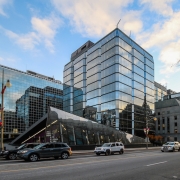In today’s real estate milieu, where cash flowing properties are becoming more sporadic by the day, the rent-to-own model is emerging as a superior strategy with a favourable buy-in.
Helping tenants take eventual ownership of a property by giving them a stake in their own success, rent-to-own investors only have to put 15% for a down payment, enlisting their tenant to put up the remaining 5%.
“This is where a lot of the profitability of rent-to-owns is coming from,” said Rachel Oliver, managing partner of Clover Properties. “Eighty percent comes from the bank, 5% from the tenant-buyer and you’re only in for 15% at a time when you can’t buy a residential property for less than 20%, but we found a way to do it.
“The sweet spot for a lot of rent-to-own properties would be an initial investment of $70,000 to 90,000.”
Rent-to-owns are ideal for supplementing income right away. Rather than banking on long-term appreciation the way most downtown Toronto condominium investors do, RTOs can yield anywhere from $600 to $900 a month in cash flow, after expenses.
But the beauty of rent-to-own investment properties is that you can leverage your personal residence or existing rentals to start building a rent-to-own portfolio that actually pays for your lifestyle. For example, a simple home equity line of credit can be used to buy multiple RTO properties, and if done properly, the investment can yield as much as $60,000 in cash flow a year, says Oliver.
“If you own a personal residence, that gives you a lot of access, especially if your residence is in the Greater Toronto Area or a major national market—you’re already leaps and bounds ahead,” she said. “It’s a number’s game: The more RTOs you get under your belt, the more cash flow you generate. If each RTO generates an average of $750 monthly cash flow, you can supplement your income by $40,000 or $50,000. Work it backwards to figure out how many properties you need, combining cash in your bank account and equity from either other investment properties that you have or equity in your home. The buy-and-holds might not cash flow as much as you need them to, and you can redirect that equity to buy rent-to-own properties.”
Of course, there’s a caveat with RTOs: In order for the investments to bear fruit, investors must know what they’re doing. Oliver reckons a single rent-to-own transaction can take as many as 80 to 100 hours from start to finish—and that excludes the learning curve.
Clover Properties has been around a decade—long enough to adapt to market fluctuations or lending rule modifications and adjust the rent-to-own strategy—and manages the entire rent-to-own transaction from start to finish for its clients.
“Our success hinges on qualifying the right tenant-buyer and we know how to do it effectively before we even have a property in the mix,” said Oliver. “When the tenant is approved, they go house hunting and then we analyze the property to make sure it’s right for our strategy, and at that point we bring the investor into the mix. There’s no other investment vehicle out there like this, but rent-to-own has to be done right, and I can’t stress that enough.”
“A lot of people think you have to gouge the tenant-buyer to get a lucrative profit, but in reality if you can access more favourable borrowing costs, you capitalize on rich cash flow,” continued Oliver. “For it to be a secure transaction, the RTO is more relationship-based than transaction-based, and the beauty of it is we want to give the homebuyer a solid springboard for success, so we look for strong down payment and stable income. When they invest a large sum in their future success, it helps the investor succeed too because they don’t tie up a lot of their own capital in the deal.”
A notable difference between typical real estate investments and rent-to-owns is that the latter helps tenants become successful owners, and investors enjoy consistent, predictable cash flow with less risk. As Oliver puts it, “we’re families helping families.”










 Maziar Moini, Broker of Record - Home Leader Realty Inc.
300 Richmond St. W., #300, Toronto, ON M5V-1X2
Maziar Moini, Broker of Record - Home Leader Realty Inc.
300 Richmond St. W., #300, Toronto, ON M5V-1X2



